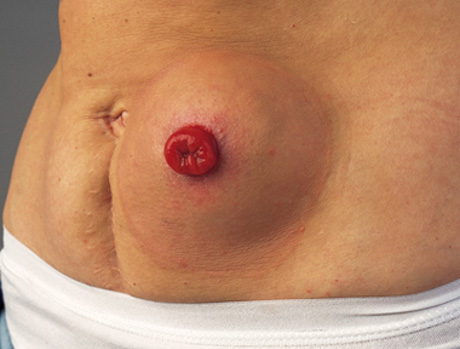

Parastomal hernias occur when one or more bowel loops pass through the muscle opening into the subcutaneous tissues (fat layer) around your stoma. 11-78% (although this percentage is varied in the literature) of people living with an ostomy may develop a parastomal hernia. Parastomal hernias occur in all types of ostomies but are more common in loop colostomy or loop ileostomy.
Prevention of a parastomal hernia is preferred but not always possible. Strategies to help prevent a parastomal hernia are to strengthen the core abdominal muscles. Often individuals may feel that they are fit and healthy as they exercised before surgery; however, my experience is that when adding an ostomy into the equation, it is essential to see a physiotherapist who specializes in core strengthening with an ostomy. Some exercises may be contra-indicated when living with an ostomy.
The wearing of a hernia belt is controversial, but I believe that wearing a hernia belt will support your stoma and muscles until you strengthen your core. Many individuals benefit from wearing a belt and like the snug fit it provides to prevent the pouch from moving around while exercising.
Determining if you have a parastomal hernia is controversial. Definition of a parastomal hernia is an opening in the muscle layer. To create your ostomy, an opening was made in the muscle. Thus, according to the definition, you already have a hernia. Most surgeons will tell you that you have a parastomal hernia as the likelihood of developing one is high. A bulge noted to one side or around the stoma is the first sign that an individual has a parastomal hernia. The individual usually notices that their abdomen is not as flat on the side of the stoma. Other times it can be seen on a C.T. scan.
The bowel loops are caught in the muscle layer and pinched off, causing an obstruction.

The management of the parastomal hernia depends on the individual and the size of the parastomal hernia. Wearing a support/hernia belt or garment can help prevent the parastomal hernia from becoming more prominent. Seeing a physiotherapist who can assist in core strengthening is important. A reassessment of your pouching system may be needed to ensure that opposing forces are not too much pressure on your skin.
If you develop complications such as an obstruction – usually noted by severe pain and decreased or no output you should seek medical attention and go to the E.R. Medical management or surgery may be necessary to resolve the issue.
A large parastomal hernia that impacts your wear time can be considered for a hernia repair surgery. This surgery will depend on your overall health and the surgeon. Evidence shows a 50% chance the parastomal hernia will reoccur, primarily if the risk factors above are not addressed.
Parastomal hernias can be small or large. For some individuals, the only complication is a slight bulge around the stoma. Complications can be divided into three aspects:
When considering a hernia belt or garment, please make an appointment with your stoma nurse. Each company's product is slightly different, and trying one on will help you decide which is the right product for you. At Macdonald's Prescriptions, our stoma nurses specialize in hernia belt fittings.